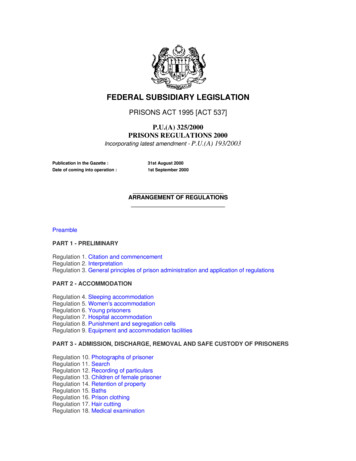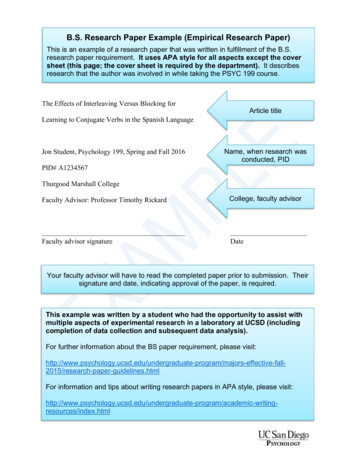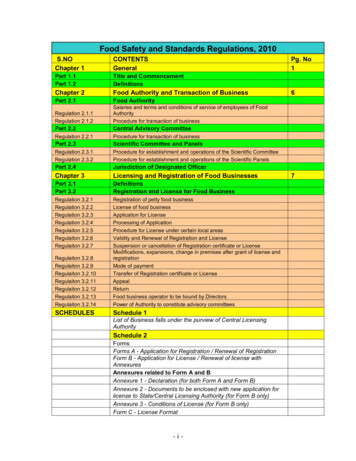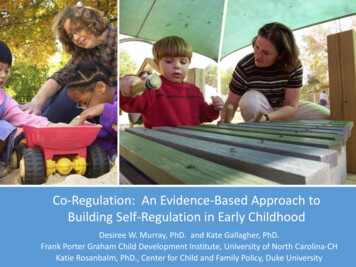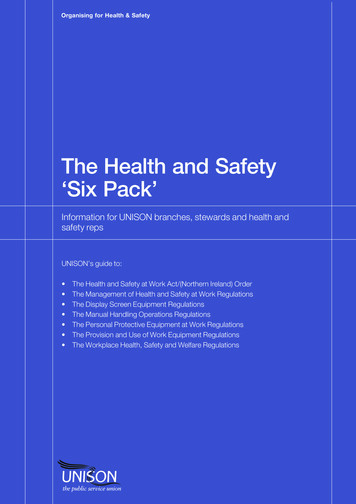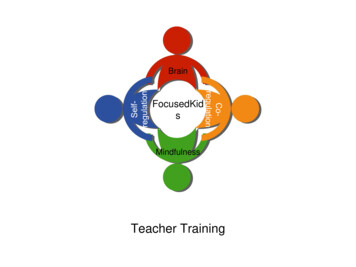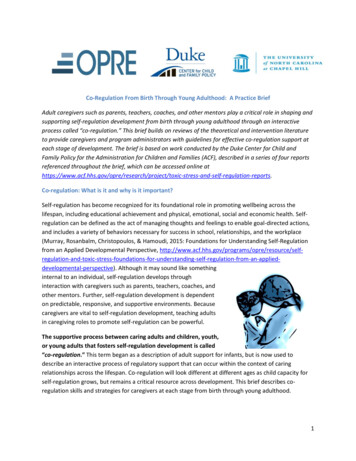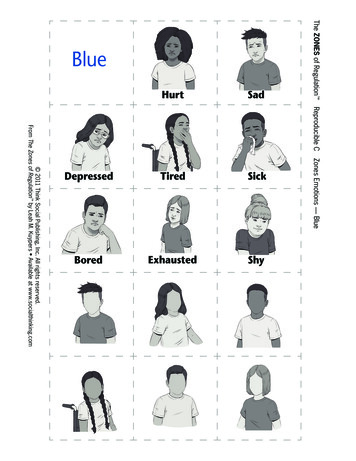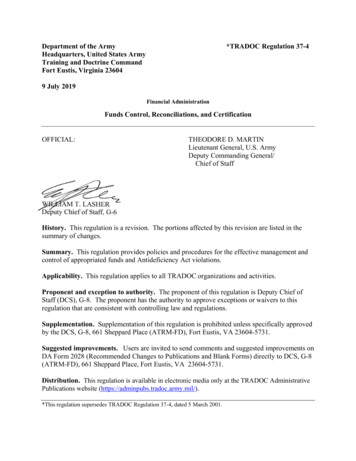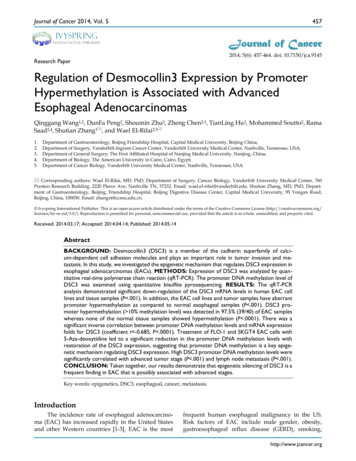
Transcription
Journal of Cancer 2014, Vol. 5457IvyspringJournal of CancerInternational Publisher2014; 5(6): 457-464. doi: 10.7150/jca.9145Research PaperRegulation of Desmocollin3 Expression by PromoterHypermethylation is Associated with AdvancedEsophageal AdenocarcinomasQinggang Wang1,2, DunFa Peng2, Shoumin Zhu2, Zheng Chen2,3, TianLing Hu2, Mohammed Soutto2, RamaSaad2,4, Shutian Zhang1 , and Wael EI-Rifai2,5 1.2.3.4.5.Department of Gastroenterology, Beijing Friendship Hospital, Capital Medical University, Beijing China;Department of Surgery, Vanderbilt-Ingram Cancer Center, Vanderbilt University Medical Center, Nashville, Tennessee, USA;Department of General Surgery; The First Affiliated Hospital of Nanjing Medical University, Nanjing, China;Department of Biology, The American University in Cairo, Cairo, Egypt;Department of Cancer Biology, Vanderbilt University Medical Center, Nashville, Tennessee, USA. Corresponding authors: Wael El-Rifai, MD, PhD, Department of Surgery, Cancer Biology, Vanderbilt University Medical Center, 760Preston Research Building, 2220 Pierce Ave, Nashville TN, 37232. Email: wael.el-rifai@vanderbilt.edu. Shutian Zhang, MD, PhD, Department of Gastroenterology, Beijing, Friendship Hospital, Beijing Digestive Disease Center, Capital Medical University, 95 Yongan Road,Beijing, China, 100050. Email: zhangst@ccmu.edu.cn. Ivyspring International Publisher. This is an open-access article distributed under the terms of the Creative Commons License ). Reproduction is permitted for personal, noncommercial use, provided that the article is in whole, unmodified, and properly cited.Received: 2014.03.17; Accepted: 2014.04.14; Published: 2014.05.14AbstractBACKGROUND: Desmocollin3 (DSC3) is a member of the cadherin superfamily of calcium-dependent cell adhesion molecules and plays an important role in tumor invasion and metastasis. In this study, we investigated the epigenetic mechanism that regulates DSC3 expression inesophageal adenocarcinomas (EACs). METHODS: Expression of DSC3 was analyzed by quantitative real-time polymerase chain reaction (qRT-PCR). The promoter DNA methylation level ofDSC3 was examined using quantitative bisulfite pyrosequencing. RESULTS: The qRT-PCRanalysis demonstrated significant down-regulation of the DSC3 mRNA levels in human EAC celllines and tissue samples (P .001). In addition, the EAC cell lines and tumor samples have aberrantpromoter hypermethylation as compared to normal esophageal samples (P .001). DSC3 promoter hypermethylation ( 10% methylation level) was detected in 97.5% (39/40) of EAC sampleswhereas none of the normal tissue samples showed hypermethylation (P .0001). There was asignificant inverse correlation between promoter DNA methylation levels and mRNA expressionfolds for DSC3 (coefficient r -0.685, P .0001). Treatment of FLO-1 and SKGT4 EAC cells with5-Aza-deoxytidine led to a significant reduction in the promoter DNA methylation levels withrestoration of the DSC3 expression, suggesting that promoter DNA methylation is a key epigenetic mechanism regulating DSC3 expression. High DSC3 promoter DNA methylation levels weresignificantly correlated with advanced tumor stage (P .001) and lymph node metastasis (P .001).CONCLUSION: Taken together, our results demonstrate that epigenetic silencing of DSC3 is afrequent finding in EAC that is possibly associated with advanced stages.Key words: epigenetics, DSC3, esophageal, cancer, metastasis.IntroductionThe incidence rate of esophageal adenocarcinoma (EAC) has increased rapidly in the United Statesand other Western countries [1-3]. EAC is the mostfrequent human esophageal malignancy in the US.Risk factors of EAC include male gender, obesity,gastroesophageal reflux disease (GERD), smoking,http://www.jcancer.org
Journal of Cancer 2014, Vol. 5and low fruit and vegetable intake [4-7]. AlthoughBarrett’s esophagus is the major risk factor for thedevelopment of EAC, the molecular underpinningsduring EAC development and progression are stilllargely unknown.Recent evidences demonstrated that hypermethylation of the gene promoter CpG island, aloneor in coordination with other genetic or epigeneticmechanisms, is one of the major mechanisms in silencing tumor suppressor genes [8, 9] as well as otherswhich are associated with key oncogenic functionssuch as angiogenesis, invasion, metastasis, and progression. Cell-cell adhesion plays a critical role incancer invasion and metastasis. Loss of cell adhesionand alterations in the expression of cadherins arecommon features of tumor cells and markers for aggressive tumor growth and poor prognosis [10, 11].Desmocollin3 (DSC3) is a member of the cadherinsuperfamily of calcium-dependent cell adhesionmolecules and a principle component of desmosomes.DSC family members are uniquely expressed in epidermal tissue, with DSC3 mainly present in the basaland spinous layers [12]. One of the more intriguingfunctions of desmosomal proteins, as they relate tocancer, is their ability to inhibit cell motility [13, 14].Down-regulation of DSC3 was reported in colorectalcancer and skin tumor [15, 16], possibly through epigenetic mechanisms and/or regulation by p53 [17]. Inthis study, we demonstrated that frequent loss ofDSC3 in EAC cell lines and primary tumor tissues ismediated by aberrant cytosine methylation of promoter regions. Furthermore, we investigated the effect of demethylation on EAC cell lines and confirmedthat demethylation treatment can restore DSC3 expression. Our results indicated that epigenetic silencing of DSC3 is a molecular event in esophageal adenocarcinomas that is progressive with advancedstages of the disease.Materials and methodsCell cultureDSC3 gene expression and DNA methylationwere analyzed in 10 cell lines originating fromesophagus, including normal esophageal squamousepithelium (HET1A and HEEC), Barrett’s esophagus(BART, CPA, and CPB) and adenocarcinomas (OE33,FLO-1, OE19, SKGT4, and JHU-Eso-Ad1). These celllines were obtained from the American Type CultureCollection (ATCC, Manassas, VA, USA), Sigma Aldrich (St. Louis, MO, USA), ScienCell Research Laboratories (Carlsbad, CA, USA), Dr. Rhonda Souza(University of Texas Southwestern), Dr. David Beer(University of Michigan), and Dr. Jim Eshleman (JohnHopkins University). The esophageal adenocarcino-458ma cell lines OE33, OE19, FLO-1, SKGT4, and JHUwere cultured in Dulbecco’s modified Eagle’s medium (DMEM) media. The immortalized Barrett’sesophagus cell lines were cultured with epithelial cellmedium 2 (ScienCell). All the cell lines were supplemented with 10% fetal bovine serum and antibiotics(100 u/ml penicillin and 100 µg/ml streptomycin(Invitrogen, Carlsbad, CA, USA) on primaria platesand flasks (BD Biosciences, Bedford, MA, USA) in a37 C incubator with 5% CO2.Esophageal tumor specimensAll frozen tissue samples were obtained from theNational Cancer Institute Cooperative Human TissueNetwork and the archives of pathology at VanderbiltUniversity (Nashville, TN, USA). The use ofde-identified archival tissue samples was approvedby the Vanderbilt institutional review board. Histopathological diagnosis of the EACs was verified basedon hematoxylin and eosin stained sections accordingto the Vienna classification of gastrointestinal epithelial neoplasia [18]. The patient ages ranged from 42-78years (median at 62.4 years). The samples included 46EAC and 30 normal esophageal squamous mucosatissue samples. The adenocarcinomas ranged fromwell-differentiated to poorly-differentiated, stagesI-IV, with a mix of intestinal- and diffuse-type tumors.Quantitative real-time RT-PCR (qRT-PCR)analyses of DSC3 expressionTotal RNAs from all the cell lines and frozenprimary tissue samples were isolated by using theRNeasy Mini Kit (Qiagen, Valencia, CA, USA), andsingle stranded cDNA was subsequently synthesizedusing the iScript cDNA synthesis kit (Bio-Rad, Hercules, CA, USA). The primers were designed using cgi-bin/primer3/primer3www.cgi). The forward and reverse primers weredesigned to span two different exons. DSC3 [forward]5’-ATCTTCAGTCGTGCTGGTGA-3’ and DSC3 [reverse] 5’-ACTTGACCGGATGAGGTCTG-3’. TheqRT-PCR was performed on a CFX Connect real-timesystem (Bio-Rad) using Bio-Rad iQ SYBR Green Supermix with the threshold cycle number determinedby the use of Bio-Rad’s CFX manager 3.0 software.Reactions were performed in triplicate, and thethreshold numbers were averaged. The results of theDSC3 gene were normalized to HPRT1, which hadminimal variation in all normal and tumor samplestested [19]. Expression fold was calculated accordingto the formula 2(Rt–Et)/2(Rn–En), where Rt is the threshold cycle number for the reference gene observed inthe tumor. Et is the threshold cycle number for theexperimental gene observed in the tumor. Rn is thehttp://www.jcancer.org
Journal of Cancer 2014, Vol. 5threshold cycle number for the for the reference geneobserved in the normal samples. En is the thresholdcycle number for the experimental gene observed inthe normal samples. For normalization of tumor dataand calculation of fold changes, the Rn and En valueswere calculated as an average of 30 normal samples.DNA sodium bisulfate modification andpyrosequencing analysisDNA from cell lines and the frozen primary tissue samples were purified using a DNeasy tissue kit(Qiagen). The bisulfite modification of the DNA wasperformed using an EZ DNA Methylation-Gold Kit(ZYMO Research, Orange, CA, USA), according to themanufacturer’s protocol. A 20 ng aliquot of modifiedDNA was subjected to polymerase chain reaction(PCR) amplification of the specific promoter regioncontaining a CpG island, by using of a primer set designed using PSQ assay design software (Qiagen),where one of the primers was biotin labeled. Theprimer set does not include CpG site that enables us toamplify both methylated and unmethylated sequences of the DSC3 gene. The primers were designed[Forward] AGGGGAGTGGGAGAATTGGT, [Reverse] CCTACCCCAAAACAACTTCACTTCT. Platinum PCR SuperMix High Fidelity (Invitrogen) wasused to prepare the PCR solution. PCR products werechecked by gel electrophoresis to confirm the size ofthe products and rule out the formation of primerdimers. Quantitative pyrosequencing analyses weredone using Biotage PyroMark MD system (Qiagen)following the protocol provided by the manufacturer.The results were analyzed by Pyro Q-CpG 1.0.9 software (Qiagen). Based on control normal samples andinternal quality controls provided in the softwareanalysis, we used a 10% DNA methylation level as acutoff for identification of DNA hypermethylation[20, 21].5-Aza-2’-Deoxycytidine and Trichostatin-ATreatmentFor validation of the role of epigenetics in transcriptional regulation of DSC3 in vitro, esophagealcancer cell lines FLO-1 and SKGT4 were used. Cellswere maintained in Dulbecco’s modified Eagle’s medium (DMEM), supplemented with 10% fetal bovineserum (FBS) and antibiotics (Invitrogen) as describedabove. Cells were seeded at low density for 24 hoursand then treated with 5 μM 5-Aza-2’-deoxycytidine(5-Aza-2’) (Sigma-Aldrich) for 72 hours and/or 200nM Trichostatin-A (TSA) (Wako, Osaka, Japan) for 24hours. Total RNA and DNA were isolated and purified by an RNeasy kit and DNeasy tissue kit (Qiagen),as described above. The DNA methylation levels ofDSC3 CpG nucleotides of the promoter were deter-459mined by pyrosequencing before and after treatments.The DSC3 mRNA expression levels were determinedby qRT-PCR, as described above.Statistical analysisThe student t test was used to compare DNAmethylation and mRNA expression between normaland tumor samples. The correlations between theDNA methylation level and mRNA expression foldwere determined by Spearman Rank Correlation. AllP-values were based on two-sided tests and differences were considered statistically significant whenP-value .05.ResultsDown-regulation of DSC3 gene expression andpromoter hypermethylation of DSC3 inesophageal adenocarcinoma cell linesThe DSC3 gene has 16 exons with a CpG islandlocated around its transcription start site (TSS, Figure1). To study DSC3 gene expression and DNA methylation in esophageal adenocarcinoma, we have collected a panel of 10 cell lines originated from esophagus, including normal esophageal squamous epithelium (HET1A and HEEC), Barrett’s esophagus (BART,CPA, and CPB) and adenocarcinomas (OE33, FLO-1,OE19, SKGT4, and JHU-Eso-Ad1). We first analyzedthe expression of DSC3 in esophageal cancer cell linesby real-time PCR. We detected significant reduction inDSC3 mRNA expression in esophageal adenocarcinoma cell lines as compared to non-neoplasticesophageal cells (Figure 2A). The pyrosequencinganalysis demonstrated significantly higher DNAmethylation levels in 4 of 5 EAC cell lines as compared to the non-neoplastic cells (Figure 2B).Frequent Promoter DNA hypermethylation ofDSC3 correlates with down-regulation ofDSC3 mRNA expression in primaryesophageal cancersWe next analyzed DSC3 mRNA expression andpromoter methylation status in normal and EAC human samples. We found that in EAC tissues, DSC3gene expression was significantly lower than in normal tissues (0.24 vs 9.36, P .001; Figure 3A) with increased promoter DNA methylation levels (% average38.6 vs 5.86, P .001; Figure 3B). Based on our results innormal samples and our previous studies, we used10% average DNA methylation level as a cutoffthreshold for hypermethylation. While 97.5% (39/40)EAC samples displayed hypermethylation, none ofthe 22 (0%) normal samples showed hypermethylation (Table 1). Spearman’s rank correlation analysisdemonstrated a significant inverse correlation between DSC3 promoter DNA methylation and mRNAhttp://www.jcancer.org
Journal of Cancer 2014, Vol. 5expression fold (coefficient r -0.685, P .0001; Figure3C). We further confirmed the above results by analyzing DNA methylation in 25 tumor samples andtheir matching adjacent histologically normal tissuesfrom the same patients (P .001, Figure 4A and 4B). Arepresentative DNA methylation status of an individual CpG site in 8 matched normal and tumorsamples is illustrated in Figure 4C. These resultssuggest that the DSC3 promoter hypermethylation isa key molecular factor involved in suppression of its460mRNA expression in EACs.Table 1. Frequency of DSC3 hypermethylation in normal andEAC samples.NNormalEAC2240DSC3 DNA methylation Level P value 10% 10% .0001220139Figure 1. DSC3 promoter CpG island and Pyrosequencing. A) A schematic chart shows DSC3 genomic structure. DSC3 has 16 exons as shown in black boxes. A CpGisland with dense CpG sites is present from -400 to 200 bp relative to the transcription start site (TSS); each vertical bar represents one CpG site. Forward and reverse primersfor Pyrosequencing assay PCR locate in the gap of CpG site and the 7 CpG sites sequenced is shown within green box. B) and C) Representative Pyrosequencing profile of the7 CpG sites in a matched normal (B) and tumor (C) sample pair, showing DNA methylation level for each individual CpG site.Figure 2. DSC3 mRNA expression and DNA methylation level in non-neoplastic esophageal cell lines and EAC cell lines. A) The expression of DSC3 in EACcell lines were significantly down-regulated compared with non-neoplastic esophageal cell lines. B) DSC3 promoter DNA methylation levels in EAC cell lines were significantlyhigher than in non-neoplastic esophageal cell lines. *** P .001, compared with the average value of normal samples.http://www.jcancer.org
Journal of Cancer 2014, Vol. 5461Figure 3. DSC3 mRNA expression and DNA methylation level in human normal and EAC tissues. A) DSC3 mRNA expression was significantly higher in normaltissues, while down-regulated in tumor tissues (relative fold was 9.36 vs 0.24; P .001). B) DSC3 promoter methylation level was low in normal samples but aberrant hypermethylation was found in EAC tissues (% average DNA methylation level was 5.86 vs 38.6 in normal and tumor respectively; P .001). A line on 10% level displays the cutoffthreshold for hypermethylation. C) The Spearman rank correlation analysis between DNA methylation level and mRNA expression fold of DSC3. Significant inverse correlationwas found (r -0.685, P .0001).Figure 4. DSC3 mRNA expression and promoter DNA methylation status in matched human normal tissues and EAC tissues. A) DSC3 gene expression wassignificantly down-regulated in tumors. B) Tumor tissues had aberrant hypermethylation levels when compared with matched normal tissues. C) Methylation levels of 8representative matching normal and tumor samples.Demethylation of DSC3 promoter restoresDSC3 mRNA expression in EAC cell linesBecause both DNA methylation and histonede-acetylation are epigenetic events that regulate geneexpression at the promoter level, we checked whetherinterference with the activities of DNA methyltransferases, using 5-Aza-2’, and/or histone deacetylases,using TSA, could restore the gene expression inesophageal adenocarcinoma cell lines. To confirm theepigenetic silencing of DSC3 gene expression, FLO-1and SKGT4, which have DSC3 promoter hypermethylation and loss of DSC3 mRNA expression, weretreated with 5-Aza-2’ alone or in combination withTSA. The results show that treatment with 5-Aza-2’alone, and not TSA alone, led to significant restorationof DSC3 mRNA expression in both FLO-1 and SKGT4cell lines (P .001; Figure 5A and 5C). The expressionof DSC3 was enhanced upon combination of 5-Aza-2’with TSA (P .001; Figure 5A and 5C). These resultssuggest that promoter hypermethylation is the primary epigenetic event whereas histone de-acetylationhas an added contribution to the regulation of DSC3expression. In concordance with these results, theDSC3 promoter DNA methylation level decreased inFLO-1 (from 92.2% to 77.2%) and in SKGT4 (from 92%to 69%), respectively (Figure 5B and 5D).DNA methylation of DSC3 gene promoterregion correlated with advanced tumor stagesTo investigate whether DSC3 promoter methylation is associated with tumor biology, we evaluatedDNA methylation levels and clinical pathological parameters. As shown in Figure 6, DSC3 DNA hypermethylation was significantly correlated with advanced tumor stage (P .001) and lymph node metastasis (P .001).http://www.jcancer.org
Journal of Cancer 2014, Vol. 5462Figure 5. Treatment with 5-Aza and TSA reverses DNA methylation and gene expression patterns of DSC3 in esophageal adenocarcinoma cell lines. A)Treatment restores gene expression in FLO-1 cell line. 5-Aza treatment alone led to significantly induction of relative mRNA expression from 1-180 fold. B) DSC3 promotermethylation level decreased in FLO-1 after treatments. C) Treatment restores gene expression in SKGT4 cell line. 5-Aza treatment alone led to significant induction of relativeexpression from 1-150 fold. D) DSC3 promoter methylation level significantly decreased in SKGT4 after treatments.Figure 6. DSC3 methylation is associated with advanced tumor stage and lymph node metastasis. A) Increased DNA methylation of DSC3 promoter correlateswith advanced tumor staging (P .001). B) Increased DNA methylation of DSC3 promoter correlates with lymph node metastasis (P .001).DiscussionEsophageal adenocarcinomas are characterizedby poor outcome, which is mainly attributed to thediagnosis of the disease at late stages with high occurrence of metastatic lesions and poor response totherapy. Although the molecular and genetic eventsunderlying tumor metastasis are still not well understood, intense investigation into this process has led tothe notion that genes and signaling pathways involved in cell adhesion and migration are critical intumor invasion and metastasis [22]. Desmocollins aretransmembrane glycoproteins and members of thecadherin superfamily of calcium-dependent cell-celladhesion molecules. There are three DSC isoforms(DSC1-3); each is a product of a separate gene. Thegenomic organization of DSCs is similar to that ofclassic cadherins [23]. In this study, we analyzed themRNA expression of DSC3 in esophageal adenocarcinoma cell lines and non-cancer esophageal epithelialcell lines. We found that the expression of DSC3 washttp://www.jcancer.org
Journal of Cancer 2014, Vol. 5significantly down-regulated or silenced in cancer celllines as compared with non-cancer epithelial cell lines.We also confirmed that in human EAC tissues, DSC3mRNA expression was significantly decreased compared with human normal esophageal tissues. Ourresults support earlier findings in other tumor subtypes, which have found down-regulation of DSC3 inbreast cancer and colorectal cancer [17, 24]. To explorethe mechanism responsible for the gene silencing inEACs, bisulfite methylation pyrosequencing was applied to quantify the DSC3 promoter methylationlevels in the cell lines and normal and cancer tissues.The results demonstrated hypermethylation of DSC3in almost all EAC samples with a strong inverse correlation between the DNA methylation and gene expression levels (r -0.685). These data suggest thatepigenetic promoter methylation is a possible regulatory mechanism of DSC3 gene expression in EAC. Infact, our results using 5-Aza and TSA confirmed theepigenetic regulation of DSC3 and suggested thatDNA methylation plays a greater role in regulatingthe expression of DSC3 than histone de-acetylation.These results add to previous findings of DSC3methylation in colorectal [25] and lung cancers[26-28]. Of note, in our assay, we detected DSC3 hypermethylation ( 10%) in all EACs except one (97.5%,39/40) whereas none of the 22 (0%) normal esophageal epithelial samples showed DSC3 hypermethylation. These results suggest that DSC3 could serve asbiomarker for Barrett’s tumorigenesis and early detection of EAC; however, large cohort studies areneeded to validate these primary observations.Previous studies have observed that loss or reduction of desmosomes contribute to the development and/or the progression of various human epithelial cancers [29, 30]. Analysis of clinical-pathological data indicated that DSC3 prompterhypermethylation was highly correlated with advanced tumor stage and lymph node metastasis(P .001). This finding is consistent with the knownfunction of DSC3, which is a member of the cadherinsuperfamily of calcium-dependent cell-cell adhesionmolecules. Similarly, loss of expression of DSC3 induced the progression of oral carcinomas and correlated with lymph node metastasis and cell proliferation [31]. Taken together, our results suggest thatDSC3 could be a novel tumor suppressor gene withinhibitory functions in invasion and metastasis inEAC.In conclusion, this is the first study reportingDNA hypermethylation and silencing of DSC3 inEACs. Further studies examining the functions ofDSC3 in EAC are needed to uncover the mechanismsby which desmosomal signaling regulates cell migra-463tion, proliferation and other biological processes inEAC.AbbreviationsNS, normal esophagus, BE, Barrett’s esophagus;EAC, esophageal adenocarcinoma; GERD, gastroesophageal reflux disease; DSC3, Desmocollin3AcknowledgementThis study was supported by grants from theNational Institute of Health; R01CA106176, Vanderbilt SPORE in Gastrointestinal Cancer (P50 CA95103),Vanderbilt Ingram Cancer Center (P30 CA68485) andthe Vanderbilt Digestive Disease Research Center(DK058404); and Department of Veterans Affairs. Thecontents of this work are solely the responsibility ofthe authors and do not necessarily represent the official views of the National Cancer Institute, Department of Veterans Affairs, or Vanderbilt University.Competing InterestsAll the authors declared no conflict of interest forthe purpose of this 5.16.17.Hur C, Miller M, Kong CY, Dowling EC, Nattinger KJ, Dunn M, et al. Trendsin esophageal adenocarcinoma incidence and mortality. Cancer. 2013; 119:1149-58. doi:10.1002/cncr.27834.Pennathur A, Gibson MK, Jobe BA, Luketich JD. Oesophageal carcinoma.Lancet. 2013; 381: 400-12. doi:10.1016/S0140-6736(12)60643-6.Pohl H, Welch HG. The role of overdiagnosis and reclassification in themarked increase of esophageal adenocarcinoma incidence. Journal of theNational Cancer Institute. 2005; 97: 142-6. doi:10.1093/jnci/dji024.Carr JS, Zafar SF, Saba N, Khuri FR, El-Rayes BF. Risk factors for risingincidence of esophageal and gastric cardia adenocarcinoma. Journal ofgastrointestinal cancer. 2013; 44: 143-51. doi:10.1007/s12029-013-9480-z.Lassen A, Hallas J, de Muckadell OB. Esophagitis: incidence and risk ofesophageal adenocarcinoma--a population-based cohort study. Am JGastroenterol. 2006; 101: 1193-9.Pohl H, Wrobel K, Bojarski C, Voderholzer W, Sonnenberg A, Rosch T, et al.Risk factors in the development of esophageal adenocarcinoma. Am JGastroenterol. 2013; 108: 200-7. doi:10.1038/ajg.2012.387.Reid BJ, Li X, Galipeau PC, Vaughan TL. Barrett's oesophagus andoesophageal adenocarcinoma: time for a new synthesis. Nature reviews. 2010;10: 87-101. doi:10.1038/nrc2773.Esteller M, Corn PG, Baylin SB, Herman JG. A gene hypermethylation profileof human cancer. Cancer Res. 2001; 61: 3225-9.Herman JG, Baylin SB. Gene silencing in cancer in association with promoterhypermethylation. N Engl J Med. 2003; 349: 2042-54.Brooke MA, Nitoiu D, Kelsell DP. Cell-cell connectivity: desmosomes anddisease. J Pathol. 2012; 226: 158-71. doi:10.1002/path.3027.Le Bras GF, Taubenslag KJ, Andl CD. The regulation of cell-cell adhesionduring epithelial-mesenchymal transition, motility and tumor progression.Cell adhesion & migration. 2012; 6: 365-73. doi:10.4161/cam.21326.Delva E, Tucker DK, Kowalczyk AP. The desmosome. Cold Spring Harborperspectives in biology. 2009; 1: a002543. doi:10.1101/cshperspect.a002543.Runswick SK, O'Hare MJ, Jones L, Streuli CH, Garrod DR. Desmosomaladhesion regulates epithelial morphogenesis and cell positioning. Nat CellBiol. 2001; 3: 823-30. doi:10.1038/ncb0901-823.Tselepis C, Chidgey M, North A, Garrod D. Desmosomal adhesion inhibitsinvasive behavior. Proc Natl Acad Sci U S A. 1998; 95: 8064-9.Chen J, O'Shea C, Fitzpatrick JE, Koster MI, Koch PJ. Loss of Desmocollin 3 inskin tumor development and progression. Mol Carcinog. 2012; 51: 535-45.doi:10.1002/mc.20818.Knosel T, Chen Y, Hotovy S, Settmacher U, Altendorf-Hofmann A, Petersen I.Loss of desmocollin 1-3 and homeobox genes PITX1 and CDX2 are associatedwith tumor progression and survival in colorectal carcinoma. Int J ColorectalDis. 2012; 27: 1391-9. doi:10.1007/s00384-012-1460-4.Cui T, Chen Y, Yang L, Knosel T, Zoller K, Huber O, et al. DSC3 expression isregulated by p53, and methylation of DSC3 DNA is a prognostic marker inhttp://www.jcancer.org
Journal of Cancer 2014, Vol. .1038/bjc.2011.28.Soutto M, Peng D, Razvi M, Ruemmele P, Hartmann A, Roessner A, et al.Epigenetic and genetic silencing of CHFR in esophageal adenocarcinomas.Cancer. 2010; 116: 4033-42. doi:10.1002/cncr.25151.El-Rifai W, Moskaluk CA, Abdrabbo MK, Harper J, Yoshida C, Riggins GJ, etal. Gastric cancers overexpress S100A calcium-binding proteins. Cancer Res.2002; 62: 6823-6.Peng D, Hu TL, Jiang A, Washington MK, Moskaluk CA, Schneider-Stock R, etal. Location-specific epigenetic regulation of the metallothionein 3 gene doi:10.1371/journal.pone.0022009 PONE-D-11-06954 [pii].Peng DF, Razvi M, Chen H, Washington K, Roessner A, Schneider-Stock R, etal. DNA hypermethylation regulates the expression of members of theMu-class glutathione S-transferases and glutathione peroxidases in Barrett'sadenocarcinoma. Gut. 2009; 58: 5-15. doi:10.1136/gut.2007.146290.Canel M, Serrels A, Frame MC, Brunton VG. E-cadherin-integrin crosstalk incancer invasion and metastasis. J Cell Sci. 2013; 126: 393-401.doi:10.1242/jcs.100115.Dusek RL, Godsel LM, Green KJ. Discriminating roles of desmosomalcadherins: beyond desmosomal adhesion. J Dermatol Sci. 2007; 45: 7-21.doi:10.1016/j.jdermsci.2006.10.006.Oshiro MM, Kim CJ, Wozniak RJ, Junk DJ, Munoz-Rodriguez JL, Burr JA, et al.Epigenetic silencing of DSC3 is a common event in human breast cancer.Breast Cancer Res. 2005; 7: R669-80. doi:10.1186/bcr1273.Oster B, Thorsen K, Lamy P, Wojdacz TK, Hansen LL, Birkenkamp-DemtroderK, et al. Identification and validation of highly frequent CpG islandhypermethylation in colorectal adenomas and carcinomas. Internationaljournal of cancer. 2011; 129: 2855-66. doi:10.1002/ijc.25951.Cui T, Chen Y, Yang L, Knosel T, Huber O, Pacyna-Gengelbach M, et al. Thep53 target gene desmocollin 3 acts as a novel tumor suppressor throughinhibiting EGFR/ERK pathway in human lung cancer. Carcinogenesis. 2012;33: 2326-33. doi:10.1093/carcin/bgs273.Cui T, Chen Y, Yang L, Mireskandari M, Knosel T, Zhang Q, et al. Diagnosticand prognostic impact of desmocollins in human lung cancer. Journal ofclinical pathology. 2012; 65: 1100-6. doi:10.1136/jclinpath-2011-200630.Yang L, Chen Y, Cui T, Knosel T, Zhang Q, Albring KF, et al. Desmoplakin actsas a tumor suppressor by inhibition of the Wnt/beta-catenin signalingpathway in human lung cancer. Carcinogenesis. 2012; 33: 1863-70.doi:10.1093/carcin/bgs226.Dubash AD, Green KJ. Desmosomes. Curr Biol. 2011; 21: R529-31.doi:10.1016/j.cub.2011.04.035.Dusek RL, Attardi LD. Desmosomes: new perpetrators in tumour suppression.Nature reviews. 2011; 11: 317-23. doi:10.1038/nrc3051.Wang L, Liu T, Wang Y, Cao L, Nishioka M, Aguirre RL, et al. Alteredexpression of desmocollin 3, desmoglein 3, and beta-catenin in oral squamouscell carcinoma: correlation with lymph node metastasis and cell proliferation.Virchows Arch. 2007; 451: 959-66. rg
verse] 5'-ACTTGACCGGATGAGGTCTG-3'. The qRT-PCR was performed on a CFX Connect real-time system (Bio-Rad) using Bio-Rad iQ SYBR Green Su-permix with the threshold cycle number determined by the use of Bio-Rad's CFX manager 3.0 software. Reactions were performed in triplicate, and the threshold numbers were averaged. The results of the
